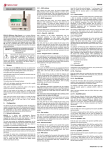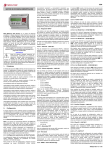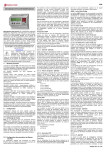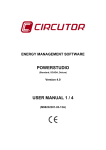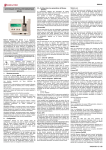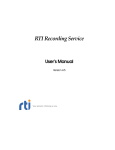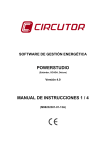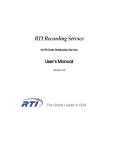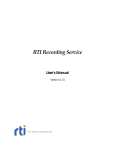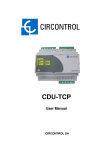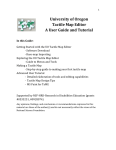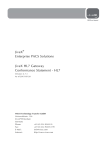Download EDS ENERGY EFFICIENCY MANAGER
Transcript
EDS EDS ENERGY EFFICIENCY MANAGER the user can use to know the physical address of the device. To go the next setup screen, press the Scroll down key. 2.2.2.- DHCP assignment After entering the setup menu, the device displays DHCP (Dynamic Host Configuration Protocol), and shows the by default NO option. To modify the option displayed on the screen, press Scroll RIGHT until the YES option appears. Do this twice and the device cyclically displays both options until one of them is validated. When the DHCP server is activated via the YES caption, press the Scroll down key to go to the next option. 2.2.2.1.- Client ID - ( DHCP YES ) EDS (Efficiency Data Server) is an energy efficiency manager. The device has an RS-485 communications bus, as well as 8 digital inputs and 6 digital outputs via relay, which allow it to communicate with external field devices, representing and storing the information via its Ethernet connection and integrated web server. EDS also has a standard XML server, through which other external applications can integrate information from the device easily and intuitively. This document represents the user and operation manual of the EDS device. If misplaced, the manual may be downloaded from CIRCUTOR's web site: www.circutor.com Disconnect the device from the power supply source before undertaking any form of maintenance, modification of connections, repairs, etc. If you suspect any operational faults in the device or in its protection system, remove the device from service. The design of the device makes it easy to replace in the event of a fault. 1.- Buttons The front panel of the EDS device has an alphanumeric LCD display, along with four function buttons, allowing the user to navigate through the setup screens of the device. The buttons have two operating methods: SHORT KEYSTROKE: when the user presses the function button for less than two seconds. LONG KEYSTROKE: when the user presses the function button for more than two seconds. The buttons have the following functions: Scroll left: edit button, scroll the cursor to the left to modify the numerical or alphanumeric digit. Scroll RIGHT: edit button, scroll the cursor to the right to modify the numerical or alphanumeric digit. Scroll up: the function of this button is to modify the digit where the edit cursor is located. If there is no cursor on the screen, move up to the next step of the previous setup option. Scroll down: the function of this button is to modify the digit where the edit cursor is located. If there is no cursor on the screen, move down to the next step of the previous setup option. 2.- Setup The device has two clear setup routes: the first one is related to the Ethernet integration start-up (IP addressing), and the second one is related to the setup of the internal application and possible association with other field devices via the RS485 bus. 2.1.- Network addressing EDS is a device with self-detecting Ethernet 10/100BaseTX connectivity. This means that, in order to integrate the device into a Local Area Network, it must be provided with a previous IP addressing configuration. The user can access the setup parameters via the display and the function keys on the front panel of the device, or through the internal setup web site, which is accessible via a conventional Internet browser. 2.2.- Network parameter setup (Keyboard) The configuration of the Ethernet network parameters can be integrally carried out using the function buttons on the front panel of the device. To access the setup menu, simultaneously hold down the keys Scroll RIGHT, Scroll up and Scroll down for more than two seconds. The device shows the text hold on 2 seconds to enter setup on screen and after 2 seconds the display shows ENTERING SETUP RELEASE THE KEYS. 2.2.1.- MAC address After entering the setup menu, the device displays MAC (Media Access Control) physical address on screen, with a 00:26:45:XX:XX:XX type format. This is an information panel that After activation of the DHCP authentication and the subsequent validation, the device displays the Client ID parameter setup on the screen, which makes reference to the DHCP name of the device to be logged into the Ethernet network. The edit cursor in the first digit is activated via the Scroll RIGHT key. This key and the Scroll up and down buttons can be used to parameterise an alphanumeric data entry of up to 20 digits. After the data is entered, press the Scroll RIGHT key twice until the edit key disappears, and then validate the data with the Scroll down key, by going to the next screen. 2.2.5.3.- Act. Mode Port - ( active mode yes ) The “Act. Mode port” option is the access port of the central server, where the AMB connections software has been installed. This computer must have an access port for connecting all remote devices, in order to establish a transparent communications tunnel. In this case, access to the Internet connection from the central location will require the use of a connection router, which will establish a NAT access rule to activate a TCP connection port in the connection server (connection path). An access port must be activated in the Internet access router, which will internally transfer the public communication frames to the AMB internal connection server and to a port specified by and known to the user. The port activated in the communication router must be configured in the "Port" section. 2.2.5.4.- Act. Mode Identifier - ( active mode yes ) Each element connected to the AMB system must have an identifier or alias (“Act. Mode Id.”). This identifier is alphanumeric and the user must record it in order to enable the server connection. An "Identifier" cannot be duplicated within the same connection server. 2.2.2.2.- Assigned values - ( DHCP YES ) 2.2.6.- Enable Security After entering the Client ID name in the device for the first time, the device displays the parameters assigned by the DHCP server on the screen. Given that the parameters that are being edited will not be fixed until the device is configured, it displays the following fields on the screen, which cannot be edited (asterisk in upper left hand corner): A user and edition password can be activated in the device, thus avoiding modification of the configuration parameters. The device displays NO by default. It should be pointed out that if the password is activated, it will be present in all the device's setup and display accesses (keyboard, Web setup and internal applications). - 2.2.8.1.- IP - 2.2.8.2.- Netmask - 2.2.8.3.- Gateway - 2.2.8.4.- Primary DNP - 2.2.8.5.- Secondary DNS Given that the DHCP server has not yet been assigned the Ethernet addressing values (displaying 000.000.000.000), press the Scroll down key twice to go the Primary NTP option. 2.2.3.- Primary NTP The device can be synchronised with a time and date NTP server (Network Time Protocol) server in the UTC time system. The device does not display a value by default, indicating that the synchronisation is completed via DHCP, if the network server allows this to be done. In this case, it is the main server. To configure an NTP server that is different from the DHCP (0.0.0.0), press the Scroll RIGHT key, enabling the edit cursor in the first digit. Set parameters for an alphanumeric data entry with the Scroll up and down buttons up to a maximum of 20 digits, indicating an http address or internal or external IP (if the device has Internet access). After establishing the parameters, press the Scroll RIGHT key twice until the edit key disappears, and then validate the data with the Scroll down key, by going to the next screen. Servers available on the Internet: - es.pool.ntp.org - pool.ntp.org 2.2.3.1.- Secondary NTP configuration of the secondary NTP server, carry out the same procedure as with the Primary NTP. 2.2.4.- Time Zone To configure the time zone, press the Scroll RIGHT key to select the time zone where the EDS device is located. After selecting the zone, press the Scroll down key, and go to the next screen. 2.2.5.- AMB® - Active Mode Bridge The AMB system reverses the connection process of remote devices. In this case, it is the equipment that starts the communication process with the connections server located in a central computer, by creating a transparent communications tunnel between the equipment and connection server. Therefore, the user avoids having to set up and maintain a fixed IP system or DynDNS in its remote control locations. 2.2.5.1.- Active mode To configure an access route, press the Scroll RIGHT key, until the YES option appears. When the Active mode is activated via the YES caption, press the Scroll down key to go to the next option. 2.2.5.2.- Act. Mode Host - ( active mode yes ) The “Act. Mode Host” option determines the IP destination where the device is actively connected. This is an alphanumerical field that can be configured with an IP address or Web routing functions. To modify the option displayed on screen, Scroll RIGHT until the option YES appears. Do this twice and the device cyclically displays both options until one of them is validated. Establish the parameters for the alphanumeric data entry with the Scroll up and down buttons, up to 20 digits corresponding to the user, and when the data is validated, repeat the operation with the password. Validate the data (Scroll right and scroll down). 2.2.7.- Confirm Changes - ( DHCP YES ) The information must be validated to save the setup. The device displays yes by default. When the completed configuration is validated, press the scroll down key and the device saves the data and leaves configuration. If the setup is not saved, Scroll RIGHT until the no option appears. Do this twice and the device cyclically displays both options until one of them is validated with the scroll down key 2.2.8.- Client ID - ( DHCP NO )* If the DHCP server is not activated, shown in section 2.2.2.DHCP assignment, validate the NO option using the Scroll down key and go to the next screen. 2.2.8.1.- IP - ( DHCP no )* The user configures an IP address for the EDS device using the configuration option. To do this, press the Scroll RIGHT key to activate the edition cursor in the first digit. Press the Scroll up and down buttons to establish the parameters of a 000.000.000.000 type numeric data entry. After establishing the parameters, press the Scroll RIGHT key twice until the edition key disappears, and then validate the data with the Scroll down key, by going to the next screen. 2.2.8.2.- NetMask - ( DHCP no )* To configure the (NetMask) setup, press the Scroll RIGHT key, activating the edition cursor in the first digit. Press the Scroll up and down buttons to establish the parameters of a 000.000.000.000 type numeric data entry. After establishing the parameters, press the Scroll RIGHT key twice until the edition key disappears, and then validate the data with the Scroll down key, by going to the next screen. 2.2.8.3.- Gateway - ( DHCP no )* To configure the Gateway setup, press the Scroll RIGHT key, activating the edit cursor in the first digit. Press the Scroll up and down buttons to parameterise a 000.000.000.000 type numeric data entry. After establishing the parameters, press the Scroll RIGHT key twice until the edition key disappears, and then validate the data with the Scroll down key, by going to the next screen. 2.2.8.4.- Primary DNS - ( DHCP no )* To configure the Primary DNS configuration, press the Scroll RIGHT key, activating the edition cursor in the first digit. Press the Scroll up and down buttons to establish the parameters of a 000.000.000.000 type numeric data entry. After establishing the parameters, press the Scroll RIGHT key twice until the edition key disappears, and then validate the data with the Scroll down key, by going to the next screen. M98237501-03-12A EDS 2.2.8.5.- Secondary DNS - ( DHCP no )* 3.- To configure the secondary DNS server, carry out the same procedure as with the Primary DNS. EDS is an energy efficiency manager with a Web server display, from which the user can see the status of the device inputs and outputs in real time, as well as any possible action to be taken. 2.2.8.6.- Other setups - ( DHCP no )* After configuring the secondary DNS, the other setup screens correspond to the same ones as in the activated DHCP mode; consequently the setup procedure will be the same as the one for sections: - 2.2.3.- Primary NTP - 2.2.3.1.- Secondary NTP - 2.2.4.- Time Zone - 2.2.5.- AMB® - Active Mode Bridge - 2.2.6.- Enable Security - 2.2.7.- Confirm Changes - ( DHCP YES ) 2.2.8.7.- Manual Date and Time setup If there is no authentication configuration by the DHCP system, and if there is no Primary and Secondary NTP server available, EDS allows the time and date to be configured manually when validating the changes by displaying the caption adjust clock. The date and time are displayed on screen with the following format: YYYY-MM-DD HH:MM. To configure them, press the Scroll RIGHT key, activating the edition cursor in the first digit. Use the Scroll up and Scroll down buttons to establish the parameters of the numerical data entry. After establishing the parameters, press the Scroll RIGHT key twice until the edition key disappears, and then validate the data with the Scroll down key, leaving setup and validating the configuration. As well as serving the data stored internally via the Web, the device has an XML server, enabling the user to send GET and PUT type requests. 3.1.- Web Server In the Address field, enter the IP address being configured; do the same with the (Netmask) and the (Gateway) port if necessary. After entering the device setup, press “Setup” to send the setup to the equipment. 2.3.2.- DHCP IP assignment To assign the DHCP name, activate the option using the upper right hand arrow and select On. Once the setup fields have been enabled, enter the MAC address. In the Address field, enter an unused, temporary IP address, which is within the working range of your computer. In the Host Name field, enter the DHCP name to be assigned to the equipment. Optionally, the user can configure the parameters of the ClientID field. The default VendorID of the device is CIRCUTOR. 2.2.9.1.- Ping system 2.3.3.- Setup web site Once connection to the Local Area Network (LAN) is established and the IP address or DHCP name is configured, the device has an internal web site where the user can integrally modify all the parameters concerning network configuration (2.2.10.- Internal setup web site), and even the time and date data. Where name_dhcp is the name assigned and authenticated by the name server of the local area network (LAN). 3.2.- XML server The XML server is an excellent integration tool for external applications. EDS has a server available whose access requests are identified in this manual (see XXX). The electronic meters have an impulse output that is proportional to the recorded power. With its inputs, EDS is a centralising unit with 8 digital inputs (opto-coupled) for reading impulses from electricity, water, gas, etc. meters. The value of these impulses is associated to 8 memory records, stored in a non-volatile memory. Each registry is 32 bits (4 bytes), so it counts a maximum of up to 4,294,967,295 impulses. When a memory record reaches this value, the meter is reset back to zero. 3.3.2.- Input logical status function (0/1) The 8 digital inputs in the device are voltage-free and have an input logical status detection function. This means that when a bridge is set up between the common and one of the digital inputs, the device detects that the input has closed, and displays the status via both communications servers. 3.4.- Digital outputs The device has 4 relay digital outputs. The user can use remote control to carry out actions on the outputs (open, close, create an impulse). When the data is validated, the screen displays the DOING PING caption and will then show the results: PING RESULT: time out - no response was obtained from the host http://dhcp_name Where xxx.xxx.xxx.xxx is the IP address assigned by the user. Its Web server and internal memory enable the user to extract graphics and tables of impulses received during a certain period (table and graphic function). The device displays the physical address within the setup menu, as shown in section 2.2.1.- MAC address. Press the SCROLL RIGHT key to go to the on-screen caption HOST PING. To enter the name or IP address to carry out the ping test, press the Scroll RIGHT key to activate the edit cursor in the first digit. Press this key and the Scroll up and down buttons to establish the parameters of an alphanumeric data entry of up to 20 digits. After the data is entered, press the Scroll RIGHT key twice until the edit key disappears, and then validate the data with the Scroll down key, by going to the next screen. PING RESULT: OK - a response was obtained from the host http://xxx.xxx.xxx.xxx - The minimum duration of the impulse or status change of the digital input must be 50 ms. The minimum time between two successive impulses must also have a minimum duration of 50 ms. This represents a maximum sampling frequency of 10 Hz. To do this, EDS has a PING section, from which the user can carry out an IP connectivity test with an IP address or name, emulating the ping command of a conventional operating system. - - 3.3.1.- Impulse meter function To confirm IP connectivity via a Local Area Network (LAN) or the Internet using a DSL or 3G router, the user sometimes has to know if the EDS device has this IP access or if the unit has particular access to a certain host. - To see the Web display interface, the user must access it via the http address below: The device has a total of 8 digital inputs, whose function is to count energy impulses coming from external sensors, or for detection of the logical status of the input. The contacts associated to the digital inputs of the device must be voltagefree dry contacts. 2.2.9.- Display of setup parameters If a user and password are available even when the user does not have one, all the setup parameters can be visualised without being able to change them (asterisk in top left hand corner). Once the Ethernet addressing is configured and integrated into the Ethernet network, the device variables are visible to the user via a conventional Internet Explorer browser (with Java plug-in installed on the computer http://www.java.com/es/download/). Another access interface is the PowerStudio Scada Client. 3.3.- Digital inputs When the setup is validated, the DONE caption appears, returning to the main screen. To display the setup parameters, the user must enter the setup menu by simultaneously pressing the SCROLL RIGHT , SCROLL UP and Scroll down keys. The user must Press the Scroll down key twice for complete visualisation of the device configuration. Operation These actions can be manual, or via programming in the events section of the device (see PowerStudio Scada manual). 3.5.- RS-485 expansion bus When a result is obtained by the device, press the Scroll down key and the device goes back to the by default display screens. 2.2.10.- Internal setup web site The device has an RS-485 communications bus that allows it to communicate with external peripherals, act as a communications master and store data recorded in its 200Mb cyclic memory. After establishing the parameters with the keyboard and connecting to the Ethernet, the device has a setup web site where the user can integrally modify the data entered with the keyboard. The setup web site is at the http address below: Its Web accessibility and memory enable the user to view data coming from devices connected to the bus in real time, and easily and simply view graphics and tables of the parameters registered by the device. - http://xxx.xxx.xxx.xxx/html/setup.html - http://dhcp_name/html/setup.html Where xxx.xxx.xxx.xxx is the IP address assigned by the user. Where name_dhcp is the name assigned and authenticated by the name server of the local area network (LAN). 2.3.- Network parameters setup (Software) Configuration of addressing can be done in the same way as using the keyboard via the IPSetup.exe file, available on a CD supplied with the device. 2.3.4.- Access via password If an access user name and password have been parameterised, the device requests these access parameters when trying to access via the web site in the following pop up screen: As well as linking communications with devices connected to its RS-485 communications bus, the device also has the capacity to make connections via IP connectivity (local or remote), either through an IP via addressing or DHCP name. To add devices to the EDS energy device setup, the user must install the PowerStudio or PowerStudio Scada application, so as to export a new setup of the device, adding new analyzers or slaves connected to the unit. EDS allows configuration of up to 5 slave devices connected to its network. 2.3.1.- Fixed IP assignment 3.6.- Additional PS/PSS features To assign a fixed IP address, enter the MAC address displayed on the device screen as shown in section 2.2.1.MAC address address, the format of which is 00:26:45:XX:XX:XX. To configure the other system features, read the PowerStudio / Scada Editor manual. It has all the information the user needs about: M98237501-03-12A EDS - Importing or exporting the setup of the EDS system - Setup of new devices or slaves - Tariff discriminators / calendars - Calculated variables - System events and alarms - Authentication setup - Web system security - Etc. Without the PowerStudio Editor tool, the measurement application cannot be configured to provide new features for the EDS device. Consequently, the user must install the software, thus making it possible to integrally configure the display server and vary the settings of the display, connected devices, alarms, etc. 4.- - devices: field identifying the XML as a response to the device list request - id: name of each one of the devices 4.3.2.- Information about the device 4.3.4.2.- Instantaneous value of all variables Request for detailed information about the devices. Each of devices you want more information, should be include in the XML sentence ?id=device1?id=device2? Request for instantaneous values of all the variables of the device (if information is needed about more devices, link the other requests below with id=device?): http://x.x.x.x/services/user/values.xml?id=device? http://x.x.x.x/services/user/deviceInfo.xml?id=device? http://dhcp_name/services/user/deviceInfo.xml?id=device ? XML instructions name.variable This way the software knows which variable it is and what device must be asked to find out the value of the variable. When an incremental variable is discriminated (energy, impulse meter or similar), the information about the parameterised discriminator is added to the basic code: - name_discriminator@type_time:variable The discriminable variables are shown in the list with an asterisk. 4.2.- EDS variables list If slave devices are provided, the frames sent to EDS are identified in the same way by name and variable, as shown in section 4.1.-. The following table shows the definition of the variables available in EDS. Digital inputs Digital Input 1 Digital input 2 Digital input 3 Digital input 4 Digital input 5 Digital input 6 Digital input 7 Digital input 8 Digital Output Status Digital Output 1 Digital Output 2 Digital Output 3 Digital Output 4 Digital Output 5 Digital Output 6 Forced Outputs Impulse Digital Output 1 Digital Output 2 Digital Output 3 Digital Output 3 Digital Output 5 Digital Output 6 Date and time Date and Time Device status Device status XML - Status Value DI1 DI2 DI3 DI4 DI5 DI6 DI7 DI8 XML - Force Output DO1 DO2 DO3 DO4 DO5 DO6 XML - Impulse DOP1 DOP2 DOP3 DOP4 DOP5 DOP6 XML - Value VDTTM XML - Impulse STATUS. XML - Meter Value C1 C2 C3 C4 C5 C6 C7 C8 Forced Open / Close 0/1 0/1 0/1 0/1 0/1 0/1 Forced Impulse ≠0 ≠0 ≠0 ≠0 ≠0 ≠0 Values Last Server communication Values 1 Communication OK 4 Not initialized 18 Port incorrect 34 Comm Errors 66 Device incorrect <var> ... </var> ... </device> ... <devices> - description: description of device - type: device type - typeDescription: detailed description of the device - var: name of each of the variables of the device; expressed as name.variable 4.3.3.- Information about the variable The user can request detailed information about one or more variables from a device and even make one single request for the information about all the variables available in the device. 4.3.3.1.- Information about one or more variables Request for detailed information about one or more variables of the device (if information is needed about more variables, link the other requests below with var=device.variable?): http://x.x.x.x/services/user/varInfo.xml?var=device.variable? http://name_dhcp/services/user/varInfo.xml?var=device.variab le? 4.3.3.2.- Information about all the variables Request for detailed information about all the variables of the device (if information is needed about more devices, link the other requests below with id=device?): http://x.x.x.x/services/user/varInfo.xml?id=device? http://dhcp_name/services/user/varInfo.xml?id=device? <varInfo> <var> <id> … </id> <title> ... </title> <hasValue> T </ hasValue> <hasLogger> T </ hasLogger> <sampleMode>… </ sampleMode> <measureUnits>… </ measureUnits> <unitsFactor>… </ unitsFactor> <decimals>… </ decimals> </ var> … <varInfo> - title: brief description of the variable - hasValue: indicates if it is possible to request the instantaneous value of the variable (True / False) 4.3.- XML Services - The requests must follow the URI standard (RFC 2396), so the user of these requests should take this detail into account when making such calls (especially in cases where the name of any device contains non-ASCII characters). Take into account that the length of the request must not under any circumstance exceed 4000 characters. hasLogger: indicates if it is possible to request the log of the variable (True / False) - sampleMode: type of variable and mode used to group values - measureUnits: variable unit - unitsFactor: power of 10 indicating the multiplying factor in the log file - decimals: decimals of the variable <devices> <id> ... </id> <devices> <value> ... </value> </ variable> ... <type> ... </type> <typeDescription> ... </typeDescription> id: variable name in device.variable format With this request the XML service returns the list of connected devices to the EDS energy efficiency manager. http://x.x.x.x/services/user/devices.xml http://name_dhcp/services/user/devices.xml <id> … </id> <description> ... </description> - 4.3.1.- Configured devices request <values> <variable> <id> ... <id> 4.1.- Type of variables - http://dhcp_name/services/user/values.xml?id=device? <devices> <device> Not only does EDS function as an excellent energy efficiency manager for local and multi-point networks, it also has a default XML requests server that enables it to be easily and intuitively integrated into a SCADA or remote monitoring system. The device, via its IP address, attends to GET and PUT requests that can carry out different functions on the device. The device has a list of available variables, in accordance with the device features. The basic code is made up of the device name and the variables separated by a dot: http://dhcp_name/services/user/values.xml?var=device.variab le? 4.3.4.- Instantaneous variable value The user can request the instantaneous values of one or more variables, and can even request the information about all the instantaneous data with just one request. 4.3.4.1.- Instantaneous value of one or more variables Request for the instantaneous value one or more variables of the device (if information is needed about more variables, link the other requests below with var=device.variable?): http://x.x.x.x/services/user/values.xml?var=device.variable? </values> - id: identifier of the variable - value: value of variable at the time of the request 4.3.5.- Historical data Request for historical data registry of an incremental variable. Returns information on one or more variables between the “begin” and “end” dates. Each variable for which information is required must be included in the request as ?var=device.variable When only the date is required, the format is DDMMYYYY; When the date and time are required, the format is DDMMYYYYHHMMSS. Both the date and the time must be expressed in UTC (Universal Coordinated Time). The grouping period can be defined by different criteria: - value in seconds (for example 900): value in seconds in which the data is grouped - ALL the data is grouped into a single value - AUTO: grouping is automatic with predefined intervals according to “begin” and “end” - FILE: data not grouped. returns the information as registered in the database - if the period parameter does not appear in the request, it is considered as value 0 and the data is not grouped http://x.x.x.x/services/user/records.xml?begin=010320110000 00?end=31032011000000?var=device.variable?period=900 http://dhcp_name/services/user/records.xml?begin=01032011 000000?end=31032011000000?var=device.variable?period= 900 <recordGroup> <period>… </ period> <record> <dateTime> ... </ dateTime > <field> <id> … </id> <value>… </value> </field> </record> … </recordGroup> - recordGroup: field identifying the XML as a response to the variable register request - period: recording period; time between recordings - record: identifies each recording (dateTime: date and time of the sample - field: standard recording value (for others consult PS manual) - value: value of variable at the time of the request. 4.3.6.- Historical events file As this user manual describes, the PowerStudio / Scada Editor makes it possible to configure events or alarms within the EDS device and record them in the internal memory. With the following request, the user can request the historical events file between the dates defined. Every event that is requested with a historical events file is defined as ?id=name_event When only the date is required, the format is DDMMYYYY; when the date and time are required, the format is DDMMYYYYHHMMSS. Both the date and the time must be expressed in Universal Coordinated Time. http://x.x.x.x/services/user/records.xml?begin=010320110000 00?end=31032011000000?id=event_name M98237501-03-12A EDS http://dhcp_name/services/user/records.xml?begin=01032011 000000?end=31032011000000? id=event_name <main> <recordGroup> <id> … </id> <record> <date>… </ date> <eventId> … </eventId> <annotation> … </annotation> <value>… </ value> </record> ... </recordGroup> … <main> 4.3.8.1.- Test commands Before initiating implementation of the active events system, there are a number of PUT type test requests between the listener and the producer (remote engine) and vice versa, the aim of which is to test and ensure connectivity between both systems. http://ip_producer:port/services/user/testListener.xml <listener> <ip>ip_listener</ip> <port>80</port> </listener> - ip_listener defines the listener's IP, to which the producer sends the response request - port: defines the listener's port, to which the producer sends the response request main: field identifying the XML as a request - recordGroup: field that groups all the recordings of an event - id: event identifier - record: identifies each record - date: event date and time http://ip_listener:port/services/user/testProducer.xml - eventId: event identifier request to which the listener must reply with "received" (200). - annotation: event annotation - value: event value OFF: inactive event ACK: event acknowledged 4.3.7.- Device events Returns the information about recorded events of one or more devices between the dates “begin” y “end”. Each device for which information is required must be included as ?id=device http://x.x.x.x/services/user/records.xml?begin=010320110000 00?end=31032011000000?id=event_name? http://dhcp_name/services/user/records.xml?begin=01032011 000000?end=31032011000000?id=event_name? When only the date is required, the format is DDMMYYYY; when the date and time are required, the format is DDMMYYYYHHMMSS. Both the date and the time must be expressed in Universal Coordinated Time. <main> <recordGroup> <device> ... </device> <record> <dateTime> … </dateTime> <field> <id> … </id> <value>… </ value> </field> … </record> ... </recordGroup> … </main> - main: field identifying the XML as a request - recordGroup: field that groups all the recordings of an event. - device: device the records make reference to - record: identifies each recording - dateTime: event date and time - field: identifies each field - id: Identifier - value: event value 4.3.8.- Active Events EDS has an XML active events service whose aim is to enable an external agent or integration system to be registered as a listener and record the events or alarms that occur in the device. The device keeps a distribution list of active users, to which it sends events that take place locally via the creation of incidents. <all>F</all> </listener> - The listener can send the request with the following message body to check connectivity with the remote search engine (producer): - ON: active event <listener> <ip>ip_listener</ip> <port>80</port> When the producer (remote search engine) receives the test request from the listener, it returns the following request: 4.3.8.2.- Registration of a listener Any agent or listener who wants to register in a remote search engine, or producer who wants to receive the incidents recorded by the search engine in real time, must carry out the following PUT request to the producer with this format: http://ip_producer:port/services/user/listener.xml This request must contain the following body in the message, in which the listener and the type of data to be received are defined: <listener> <ip>ip_listener</ip> <port>80</port> <all>T</all> <listener> - ip_listener the listener's IP is defined, to which the producer sends the events that are created - port: defines the listener's port, to which the producer sends the events that are created The all section defines the type of information that is to be accessed (True / False). - True:) indicates to the producer that all the active events list available must be sent - False:) indicates to the producer that only the events that took place since the last request must be sent 4.3.8.5.- Reception of events When there is any change in the events, the request that the producer creates against the listeners' distribution list giving information about the events is PUT type with the following Syntax: http://ip_oyente:port/services/user/producer.xml The request contains the following information in XML format in the body of the message: information about the events produced: <producer> <all>T/F</all> <event> <id>driverId.driverId.driverId…eventId</id> <name>Event 1</name> <description>Description 1</description> <annotation>Annotation 1</annotation> <dateTime>25112010201034</dateTime> <whyFired>ACTIVATION</whyFired> </event> <event> <id>driverId.driverId.driverId…eventId</id> <name>Event 2</name> <description>Description 2</description> <annotation>Annotation 2</annotation> <dateTime>25112010201034</dateTime> <disabledDateTime>25112010201103</ disabledDateTime > <whyFired>DEACTIVATION</whyFired> </event> … </producer> - all: all the events (True) or changes(False) - event-id: producer and identifier of the event - whyFired: ACTIVATION, DEACTIVATION Notes referring to the active events: - 4.3.8.3.- Deletion or loss of the listeners' list The producer can completely or partially lose or eliminate the listeners' list for different reasons: - The listener does not answer: when new events or changes in these events take place, the producer instantaneously informs all listeners on the list. When the producer is faced with a communication problem with a listener, a total of fifty retries are made to send information. If the listener does not respond to these requests, the producer deregisters the listener from the distribution list. - The producer has rebooted or has temporarily stopped operating: if the producer receives an update or generates a reset for any reason, (firmware, update, loss of power supply, etc), the entire listeners' list is lost and from then on stops sending events to the previously associated listeners. 4.3.8.4.- Maintenance of the listeners' list (alive) Given that there are several reasons why the listeners' list might be totally or partially affected, the external integration system needs to implement an (alive) test system against the producer to ensure that the IP is kept active for a long period in the distribution list. It is recommended that the test system is automatic and with a periodicity of no more than 10 minutes between each test frame dispatch. The (alive) test system is based on the updating of the listener IP, again against the producer, although only the event changes are requested (False): If the external integration application has remained inactive for a long period of time, a request to the producer asking for the entire list of active events is recommended using a True request. This way the listener again has all the information lost during the period of inactivity. Note: if the producer has implemented http authentication by user and password, it must be implemented in the listener by the user. 4.3.9.- Forcing of variables This request is used to send the variable forcing order (or writing) to the system. The request should include the name of the device that wants to make the request. It is important to incorporate the authentication data when this is necessary. <forceVariables> <forceVar> <forceName> ... </forceName> <forceValue> ... </forceValue> </record> </ forceVar> ... </forceVariables> - forceVariables: field identifying the XML as a request - forceVar: Information from each variable to be forced - forceName: variable name in device.variable format - field: identifies each field http://ip_producer:port/services/user/listener.xml This request must contain the following body in the message, in which the listener and the type of data to be received are again defined: M98237501-03-12A EDS 5.- Technical specifications Power circuit: - Single-phase (phase – neutral) A1 – A2 : - Frequency: - Maximum consumption: - Working temperature: - Water content (non-condensing): Mechanical features: - Case material: - Equipment protection degree: - Dimensions (mm): - Weight: - Maximum operating height: Inputs features: - Type: - Maximum activation current: - Insulation: Network interface: - Type: - Connector: - Network protocols: Serial interface: - Type: - Transmission speed (configurable): - Data bits: - Parity: - Stop bit 6.- Standard version 85…264 V ac / 120…300 V dc 47…63 Hz 5…8 VA -10 …+ 60 ºC 5 … 95 % UL94 - V0 self-extinguishing plastic IP 20 105 x 70 x 90 mm (6 modules) 250 g 2,000 m Voltage-free opto-insulated (dry contact) 50 mA 1500 V Ethernet 10BaseT / 100BaseTX self-detectable RJ45 HTTP / Modbus/RTU in RS-485 bus Three-wire RS-485 (A/B/S) 4800, 9600, 19,200, 34,800, 57,600, 115,200 bps 8 No parity, odd, even 1/2 Relay 750 VA 250 V ac 5 A with resistive load 3 x 104 operations 2 x 107 operations LED symbols: - Power : - Slaves: - Left RJ45 led: - Right RJ45 led: Equipment power supply and CPU activity Communicating slave devices shutdown Green: Full duplex / Yellow: Half duplex / Activity Green: 100 Mb/s / Yellow: 10 Mb/s / Link Display: - Type: - Characters: - Back lighting: 2 lines, alphanumeric 20 Yes Safety: Installation category Class III / EN61010 double-insulated electric shock protection class II. Connect the device to a power circuit protected with gl fuses in compliance with IEC 269, or M fuses, with values from 0.5 to 1A. It must be fitted with a circuit breaker switch or equivalent device, in order to be able to disconnect the device from the power supply. The power supply cable must have a cross-section of at least 1 mm2. Standards: EC, IEC 60664, VDE 0110, UL 94, EN61010-1, EN55011, EN 61000-4-2, EN 61000-4-3, 61000-4-11, EN 61000-6-4, EN 61000-6-2, EN 61000-6-1, EN 61000-6-3, EN 61000-4-5 Connections DETAILS OF THE POWER SUPPLY AND RS-485 COMMUNICATION (SLAVE EQUIPMENT) CONNECTIONS 7.- Output Features: - Type: - Maximum switching power: - Maximum switching voltage: - Maximum switching intensity: - Electrical life (250 Vac / 5 A): - Mechanical working life: DETAILS OF DIGITAL INPUT 4 ACTIVATION Technical Service If you have any doubts about the operation of the unit or suspect any malfunction, contact our service staff at CIRCUTOR, SA CIRCUTOR, SA - Technical Assistance Service Vial Sant Jordi, s/n 08232 – Viladecavalls (Barcelona), SPAIN Tel.: 902 449 459 (Spain) Tel.: +34 937 452 900 (outside Spain) e-mail: [email protected] M98237501-03-12A





